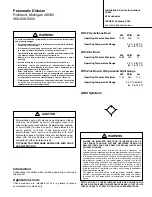
Rev 14.0/5-13
23
MRTA6-DC: #35072
Identify the input voltage marked on the battery charger, and plug it in to an appropriate power
source.
15
The power source must be equipped with a ground fault circuit interrupter, in order to
reduce the risk of electrical shocks.
WARNING: Power source must be equipped with ground fault circuit interrupter.
Usually a battery takes no more than 16 hours to charge completely, after which the charger
shuts off automatically. The blue light on the battery gauge also turns on, to indicate that the
battery is fully charged. Following long-term use, a battery gradually loses capacity. Replace it
whenever the operating time between recharging is no longer satisfactory.
B
ATTERY
C
HARGER
T
EST
Perform this test only when the battery is
not fully charged (see B
ATTERY
T
EST
preceding). While
the valve handle is in the “RELEASE” position (power
off) and the battery charger is disconnected
from any AC power source, use the battery test button to take an energy reading on the battery
gauge. Then plug the charger in to an appropriate AC power source and allow a few moments
for the battery gauge to show an accurate energy reading. If the charger is functioning
correctly, the energy reading should be higher when the charger is plugged in.
V
ACUUM
P
AD
M
AINTENANCE
Friction Coefficient
The friction coefficient represents the lifter's ability to resist load slippage when the load is
oriented in any position except horizontal. If the contact surfaces of either the load or the
vacuum pads are not clean, dry and in good condition, slippage is more likely to occur.
The Load Capacity of most Powr-Grip lifters is based on a friction coefficient of 1 (only Flat Lifters
are exempt from this requirement). However, a vacuum pad's ability to maintain this friction
coefficient is reduced by factors such as contamination, wear, age and exposure to sunlight, as
well as the condition of the load's contact surface (see INTENDED USE: L
OAD
C
HARACTERISTICS
).
Pads that have surface contamination must be thoroughly cleaned (see Cleaning discussion to
follow). Over time, the rubber in a pad may experience hardening or leaching of chemicals,
resulting in stiffness or surface glaze. Pads that exhibit wear, stiffness or glaze must be replaced.
In addition, all pads should be replaced on a regular basis, preferably after no more than 2 years,
to ensure that the friction coefficient is not compromised. If necessary, contact your dealer or
Wood's Powr-Grip for more information.
Inspection
Inspect each vacuum pad for the following deficiencies routinely, as directed in the preceding
I
NSPECTION
and T
ESTING
S
CHEDULES
. Correct any deficiency before using the lifter.
• Contaminates on the pad face or sealing edges: Soil build-up can prevent pads from sealing
adequately or reduce the friction coefficient (see discussion preceding). Follow the directions
to clean pads as necessary (see discussion to follow).
15
Any external power supply must conform to all applicable local codes.
Summary of Contents for MRTA610DCO
Page 2: ......











































